Quality Management Report: Business and Service Provision
VerifiedAdded on 2020/01/21
|19
|6432
|62
Report
AI Summary
This report provides a comprehensive overview of quality management in the context of business and service provision. It begins by defining quality from various perspectives, including David Garvin's Eight Product Quality Dimensions and PZ&B's service quality dimensions, and explores the roles of quality control and quality assurance in inspection processes. The report then delves into different approaches to quality management, such as transcendental, manufacturing-based, value-based, product-based, and user-based approaches, highlighting their similarities and differences. Customer satisfaction is defined and linked to continuous improvement, and the report outlines the benefits of continuous improvement and the importance of measuring quality. The report also covers methods for determining customer needs, including surveys and consultation methods, and discusses the role of self-assessment, communication, and staff consultation in improving service quality. Through these analyses, the report aims to provide a holistic understanding of quality management principles and their application in real-world scenarios.
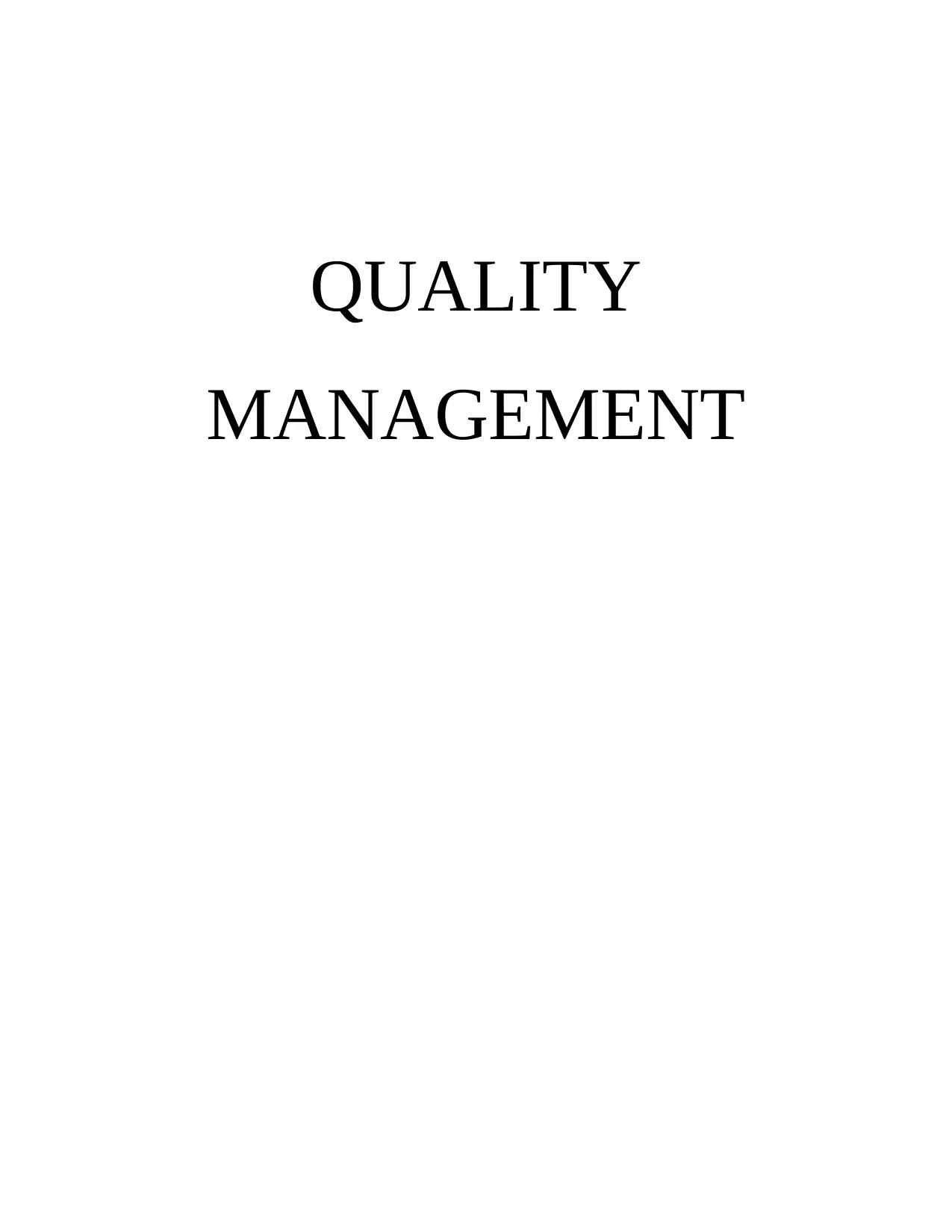
QUALITY
MANAGEMENT
MANAGEMENT
Paraphrase This Document
Need a fresh take? Get an instant paraphrase of this document with our AI Paraphraser
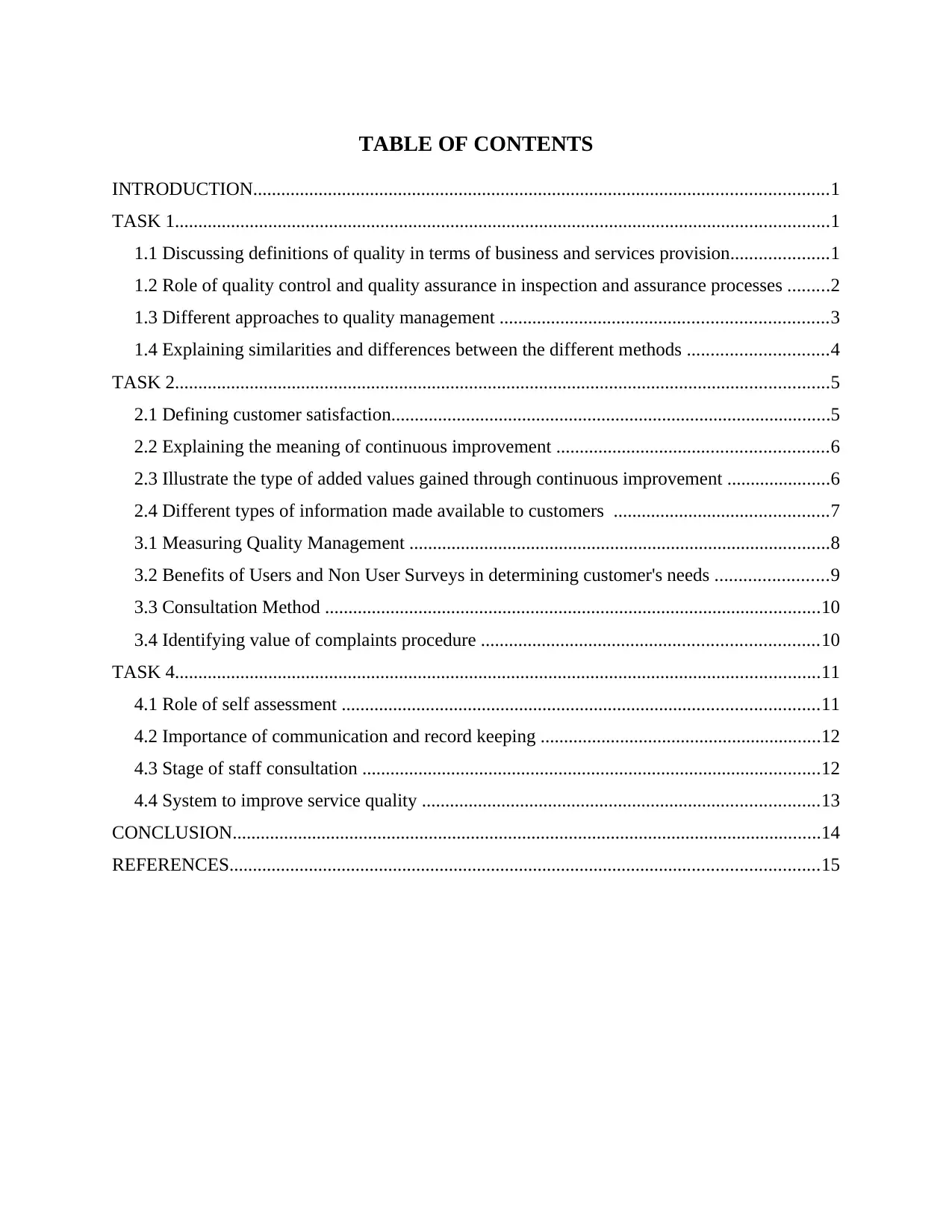
TABLE OF CONTENTS
INTRODUCTION...........................................................................................................................1
TASK 1............................................................................................................................................1
1.1 Discussing definitions of quality in terms of business and services provision.....................1
1.2 Role of quality control and quality assurance in inspection and assurance processes .........2
1.3 Different approaches to quality management ......................................................................3
1.4 Explaining similarities and differences between the different methods ..............................4
TASK 2............................................................................................................................................5
2.1 Defining customer satisfaction..............................................................................................5
2.2 Explaining the meaning of continuous improvement ..........................................................6
2.3 Illustrate the type of added values gained through continuous improvement ......................6
2.4 Different types of information made available to customers ..............................................7
3.1 Measuring Quality Management ..........................................................................................8
3.2 Benefits of Users and Non User Surveys in determining customer's needs ........................9
3.3 Consultation Method ..........................................................................................................10
3.4 Identifying value of complaints procedure ........................................................................10
TASK 4..........................................................................................................................................11
4.1 Role of self assessment ......................................................................................................11
4.2 Importance of communication and record keeping ............................................................12
4.3 Stage of staff consultation ..................................................................................................12
4.4 System to improve service quality .....................................................................................13
CONCLUSION..............................................................................................................................14
REFERENCES..............................................................................................................................15
INTRODUCTION...........................................................................................................................1
TASK 1............................................................................................................................................1
1.1 Discussing definitions of quality in terms of business and services provision.....................1
1.2 Role of quality control and quality assurance in inspection and assurance processes .........2
1.3 Different approaches to quality management ......................................................................3
1.4 Explaining similarities and differences between the different methods ..............................4
TASK 2............................................................................................................................................5
2.1 Defining customer satisfaction..............................................................................................5
2.2 Explaining the meaning of continuous improvement ..........................................................6
2.3 Illustrate the type of added values gained through continuous improvement ......................6
2.4 Different types of information made available to customers ..............................................7
3.1 Measuring Quality Management ..........................................................................................8
3.2 Benefits of Users and Non User Surveys in determining customer's needs ........................9
3.3 Consultation Method ..........................................................................................................10
3.4 Identifying value of complaints procedure ........................................................................10
TASK 4..........................................................................................................................................11
4.1 Role of self assessment ......................................................................................................11
4.2 Importance of communication and record keeping ............................................................12
4.3 Stage of staff consultation ..................................................................................................12
4.4 System to improve service quality .....................................................................................13
CONCLUSION..............................................................................................................................14
REFERENCES..............................................................................................................................15
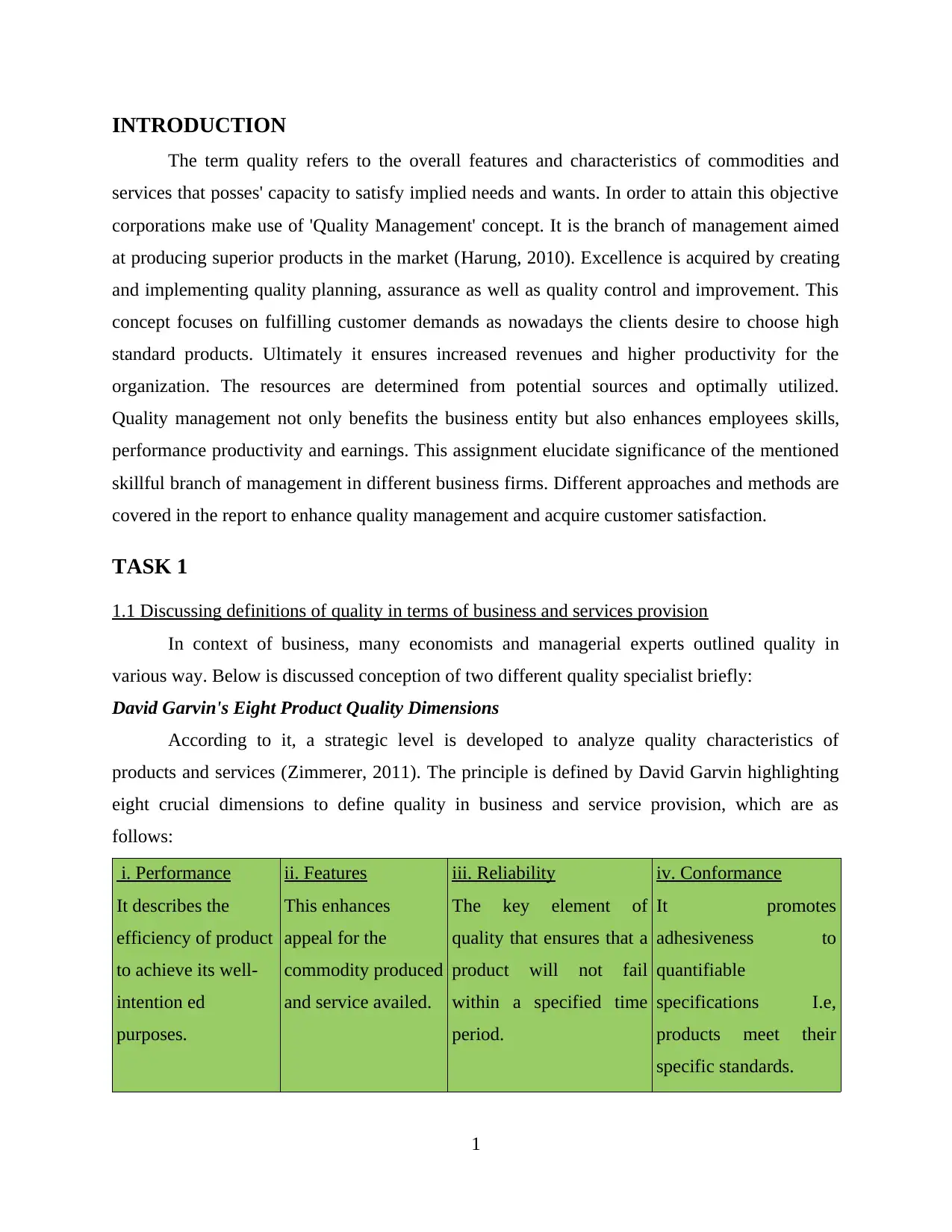
INTRODUCTION
The term quality refers to the overall features and characteristics of commodities and
services that posses' capacity to satisfy implied needs and wants. In order to attain this objective
corporations make use of 'Quality Management' concept. It is the branch of management aimed
at producing superior products in the market (Harung, 2010). Excellence is acquired by creating
and implementing quality planning, assurance as well as quality control and improvement. This
concept focuses on fulfilling customer demands as nowadays the clients desire to choose high
standard products. Ultimately it ensures increased revenues and higher productivity for the
organization. The resources are determined from potential sources and optimally utilized.
Quality management not only benefits the business entity but also enhances employees skills,
performance productivity and earnings. This assignment elucidate significance of the mentioned
skillful branch of management in different business firms. Different approaches and methods are
covered in the report to enhance quality management and acquire customer satisfaction.
TASK 1
1.1 Discussing definitions of quality in terms of business and services provision
In context of business, many economists and managerial experts outlined quality in
various way. Below is discussed conception of two different quality specialist briefly:
David Garvin's Eight Product Quality Dimensions
According to it, a strategic level is developed to analyze quality characteristics of
products and services (Zimmerer, 2011). The principle is defined by David Garvin highlighting
eight crucial dimensions to define quality in business and service provision, which are as
follows:
i. Performance
It describes the
efficiency of product
to achieve its well-
intention ed
purposes.
ii. Features
This enhances
appeal for the
commodity produced
and service availed.
iii. Reliability
The key element of
quality that ensures that a
product will not fail
within a specified time
period.
iv. Conformance
It promotes
adhesiveness to
quantifiable
specifications I.e,
products meet their
specific standards.
1
The term quality refers to the overall features and characteristics of commodities and
services that posses' capacity to satisfy implied needs and wants. In order to attain this objective
corporations make use of 'Quality Management' concept. It is the branch of management aimed
at producing superior products in the market (Harung, 2010). Excellence is acquired by creating
and implementing quality planning, assurance as well as quality control and improvement. This
concept focuses on fulfilling customer demands as nowadays the clients desire to choose high
standard products. Ultimately it ensures increased revenues and higher productivity for the
organization. The resources are determined from potential sources and optimally utilized.
Quality management not only benefits the business entity but also enhances employees skills,
performance productivity and earnings. This assignment elucidate significance of the mentioned
skillful branch of management in different business firms. Different approaches and methods are
covered in the report to enhance quality management and acquire customer satisfaction.
TASK 1
1.1 Discussing definitions of quality in terms of business and services provision
In context of business, many economists and managerial experts outlined quality in
various way. Below is discussed conception of two different quality specialist briefly:
David Garvin's Eight Product Quality Dimensions
According to it, a strategic level is developed to analyze quality characteristics of
products and services (Zimmerer, 2011). The principle is defined by David Garvin highlighting
eight crucial dimensions to define quality in business and service provision, which are as
follows:
i. Performance
It describes the
efficiency of product
to achieve its well-
intention ed
purposes.
ii. Features
This enhances
appeal for the
commodity produced
and service availed.
iii. Reliability
The key element of
quality that ensures that a
product will not fail
within a specified time
period.
iv. Conformance
It promotes
adhesiveness to
quantifiable
specifications I.e,
products meet their
specific standards.
1
⊘ This is a preview!⊘
Do you want full access?
Subscribe today to unlock all pages.

Trusted by 1+ million students worldwide
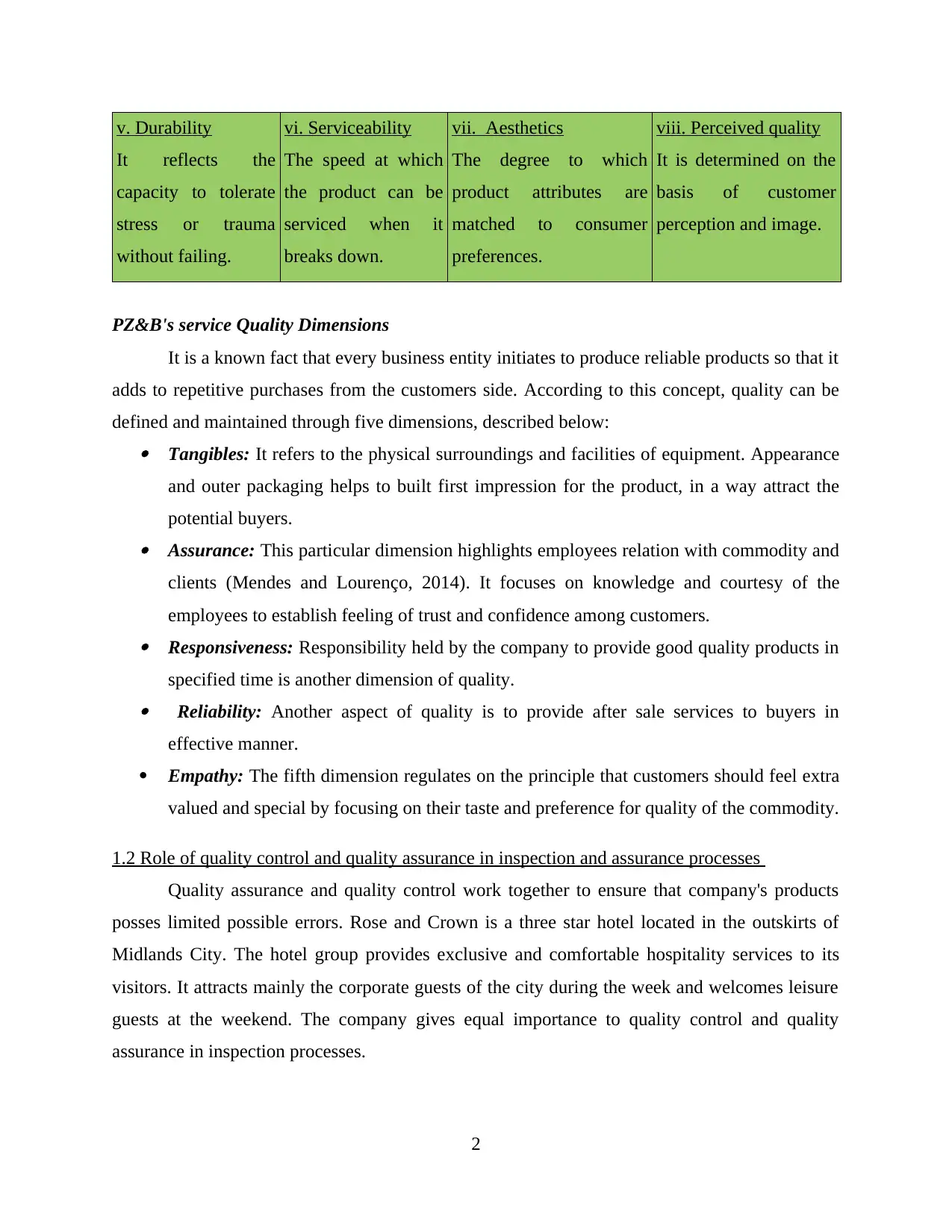
v. Durability
It reflects the
capacity to tolerate
stress or trauma
without failing.
vi. Serviceability
The speed at which
the product can be
serviced when it
breaks down.
vii. Aesthetics
The degree to which
product attributes are
matched to consumer
preferences.
viii. Perceived quality
It is determined on the
basis of customer
perception and image.
PZ&B's service Quality Dimensions
It is a known fact that every business entity initiates to produce reliable products so that it
adds to repetitive purchases from the customers side. According to this concept, quality can be
defined and maintained through five dimensions, described below: Tangibles: It refers to the physical surroundings and facilities of equipment. Appearance
and outer packaging helps to built first impression for the product, in a way attract the
potential buyers. Assurance: This particular dimension highlights employees relation with commodity and
clients (Mendes and Lourenço, 2014). It focuses on knowledge and courtesy of the
employees to establish feeling of trust and confidence among customers. Responsiveness: Responsibility held by the company to provide good quality products in
specified time is another dimension of quality. Reliability: Another aspect of quality is to provide after sale services to buyers in
effective manner.
Empathy: The fifth dimension regulates on the principle that customers should feel extra
valued and special by focusing on their taste and preference for quality of the commodity.
1.2 Role of quality control and quality assurance in inspection and assurance processes
Quality assurance and quality control work together to ensure that company's products
posses limited possible errors. Rose and Crown is a three star hotel located in the outskirts of
Midlands City. The hotel group provides exclusive and comfortable hospitality services to its
visitors. It attracts mainly the corporate guests of the city during the week and welcomes leisure
guests at the weekend. The company gives equal importance to quality control and quality
assurance in inspection processes.
2
It reflects the
capacity to tolerate
stress or trauma
without failing.
vi. Serviceability
The speed at which
the product can be
serviced when it
breaks down.
vii. Aesthetics
The degree to which
product attributes are
matched to consumer
preferences.
viii. Perceived quality
It is determined on the
basis of customer
perception and image.
PZ&B's service Quality Dimensions
It is a known fact that every business entity initiates to produce reliable products so that it
adds to repetitive purchases from the customers side. According to this concept, quality can be
defined and maintained through five dimensions, described below: Tangibles: It refers to the physical surroundings and facilities of equipment. Appearance
and outer packaging helps to built first impression for the product, in a way attract the
potential buyers. Assurance: This particular dimension highlights employees relation with commodity and
clients (Mendes and Lourenço, 2014). It focuses on knowledge and courtesy of the
employees to establish feeling of trust and confidence among customers. Responsiveness: Responsibility held by the company to provide good quality products in
specified time is another dimension of quality. Reliability: Another aspect of quality is to provide after sale services to buyers in
effective manner.
Empathy: The fifth dimension regulates on the principle that customers should feel extra
valued and special by focusing on their taste and preference for quality of the commodity.
1.2 Role of quality control and quality assurance in inspection and assurance processes
Quality assurance and quality control work together to ensure that company's products
posses limited possible errors. Rose and Crown is a three star hotel located in the outskirts of
Midlands City. The hotel group provides exclusive and comfortable hospitality services to its
visitors. It attracts mainly the corporate guests of the city during the week and welcomes leisure
guests at the weekend. The company gives equal importance to quality control and quality
assurance in inspection processes.
2
Paraphrase This Document
Need a fresh take? Get an instant paraphrase of this document with our AI Paraphraser
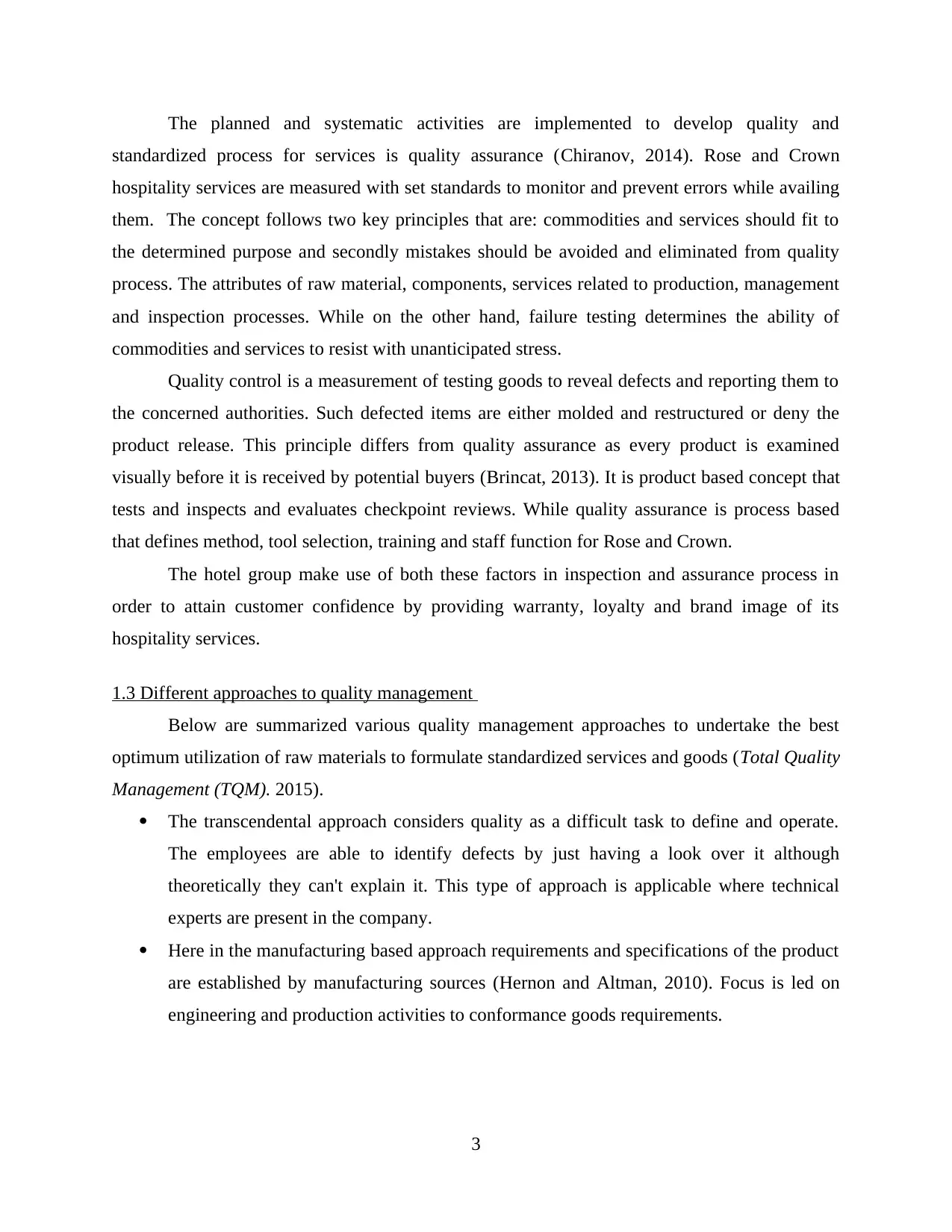
The planned and systematic activities are implemented to develop quality and
standardized process for services is quality assurance (Chiranov, 2014). Rose and Crown
hospitality services are measured with set standards to monitor and prevent errors while availing
them. The concept follows two key principles that are: commodities and services should fit to
the determined purpose and secondly mistakes should be avoided and eliminated from quality
process. The attributes of raw material, components, services related to production, management
and inspection processes. While on the other hand, failure testing determines the ability of
commodities and services to resist with unanticipated stress.
Quality control is a measurement of testing goods to reveal defects and reporting them to
the concerned authorities. Such defected items are either molded and restructured or deny the
product release. This principle differs from quality assurance as every product is examined
visually before it is received by potential buyers (Brincat, 2013). It is product based concept that
tests and inspects and evaluates checkpoint reviews. While quality assurance is process based
that defines method, tool selection, training and staff function for Rose and Crown.
The hotel group make use of both these factors in inspection and assurance process in
order to attain customer confidence by providing warranty, loyalty and brand image of its
hospitality services.
1.3 Different approaches to quality management
Below are summarized various quality management approaches to undertake the best
optimum utilization of raw materials to formulate standardized services and goods (Total Quality
Management (TQM). 2015).
The transcendental approach considers quality as a difficult task to define and operate.
The employees are able to identify defects by just having a look over it although
theoretically they can't explain it. This type of approach is applicable where technical
experts are present in the company.
Here in the manufacturing based approach requirements and specifications of the product
are established by manufacturing sources (Hernon and Altman, 2010). Focus is led on
engineering and production activities to conformance goods requirements.
3
standardized process for services is quality assurance (Chiranov, 2014). Rose and Crown
hospitality services are measured with set standards to monitor and prevent errors while availing
them. The concept follows two key principles that are: commodities and services should fit to
the determined purpose and secondly mistakes should be avoided and eliminated from quality
process. The attributes of raw material, components, services related to production, management
and inspection processes. While on the other hand, failure testing determines the ability of
commodities and services to resist with unanticipated stress.
Quality control is a measurement of testing goods to reveal defects and reporting them to
the concerned authorities. Such defected items are either molded and restructured or deny the
product release. This principle differs from quality assurance as every product is examined
visually before it is received by potential buyers (Brincat, 2013). It is product based concept that
tests and inspects and evaluates checkpoint reviews. While quality assurance is process based
that defines method, tool selection, training and staff function for Rose and Crown.
The hotel group make use of both these factors in inspection and assurance process in
order to attain customer confidence by providing warranty, loyalty and brand image of its
hospitality services.
1.3 Different approaches to quality management
Below are summarized various quality management approaches to undertake the best
optimum utilization of raw materials to formulate standardized services and goods (Total Quality
Management (TQM). 2015).
The transcendental approach considers quality as a difficult task to define and operate.
The employees are able to identify defects by just having a look over it although
theoretically they can't explain it. This type of approach is applicable where technical
experts are present in the company.
Here in the manufacturing based approach requirements and specifications of the product
are established by manufacturing sources (Hernon and Altman, 2010). Focus is led on
engineering and production activities to conformance goods requirements.
3
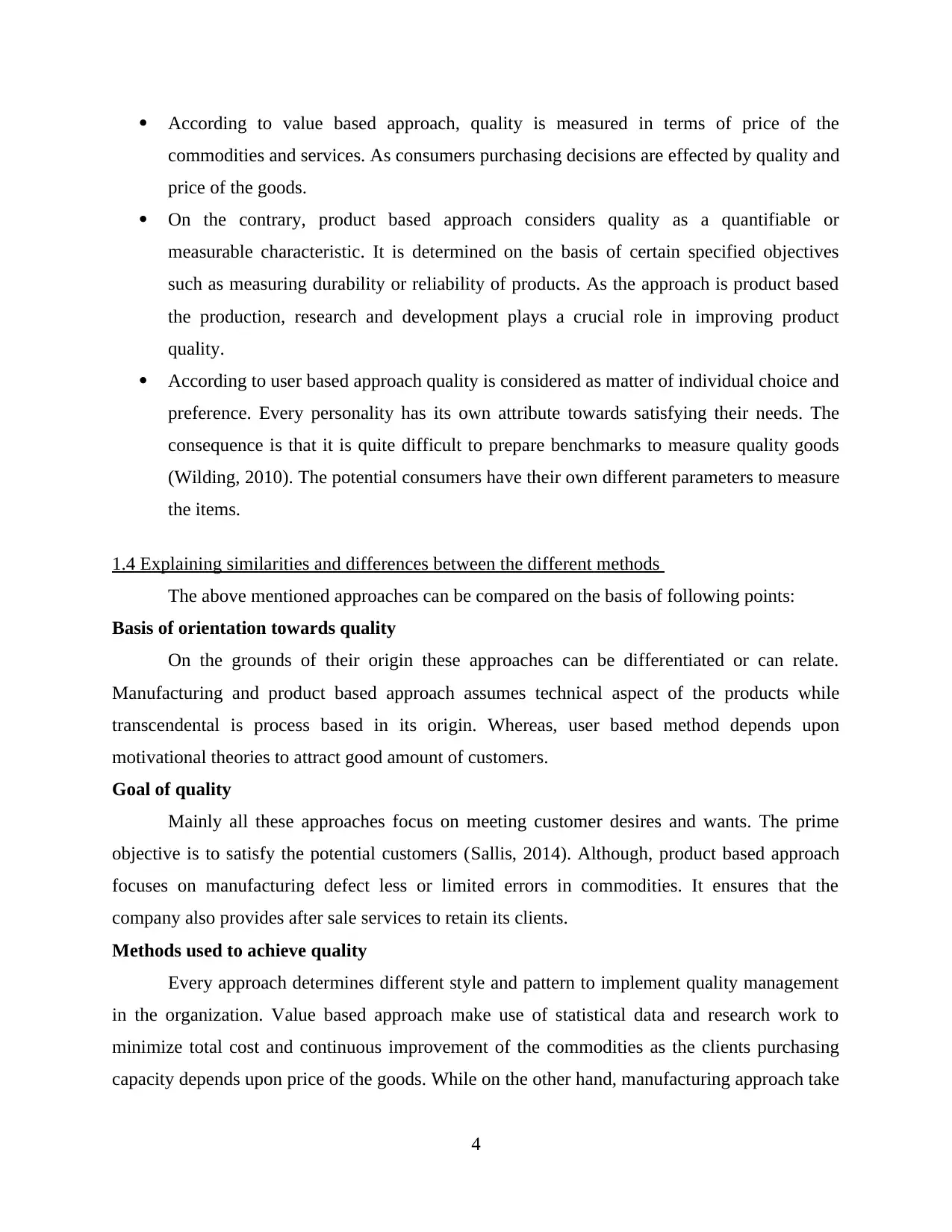
According to value based approach, quality is measured in terms of price of the
commodities and services. As consumers purchasing decisions are effected by quality and
price of the goods.
On the contrary, product based approach considers quality as a quantifiable or
measurable characteristic. It is determined on the basis of certain specified objectives
such as measuring durability or reliability of products. As the approach is product based
the production, research and development plays a crucial role in improving product
quality.
According to user based approach quality is considered as matter of individual choice and
preference. Every personality has its own attribute towards satisfying their needs. The
consequence is that it is quite difficult to prepare benchmarks to measure quality goods
(Wilding, 2010). The potential consumers have their own different parameters to measure
the items.
1.4 Explaining similarities and differences between the different methods
The above mentioned approaches can be compared on the basis of following points:
Basis of orientation towards quality
On the grounds of their origin these approaches can be differentiated or can relate.
Manufacturing and product based approach assumes technical aspect of the products while
transcendental is process based in its origin. Whereas, user based method depends upon
motivational theories to attract good amount of customers.
Goal of quality
Mainly all these approaches focus on meeting customer desires and wants. The prime
objective is to satisfy the potential customers (Sallis, 2014). Although, product based approach
focuses on manufacturing defect less or limited errors in commodities. It ensures that the
company also provides after sale services to retain its clients.
Methods used to achieve quality
Every approach determines different style and pattern to implement quality management
in the organization. Value based approach make use of statistical data and research work to
minimize total cost and continuous improvement of the commodities as the clients purchasing
capacity depends upon price of the goods. While on the other hand, manufacturing approach take
4
commodities and services. As consumers purchasing decisions are effected by quality and
price of the goods.
On the contrary, product based approach considers quality as a quantifiable or
measurable characteristic. It is determined on the basis of certain specified objectives
such as measuring durability or reliability of products. As the approach is product based
the production, research and development plays a crucial role in improving product
quality.
According to user based approach quality is considered as matter of individual choice and
preference. Every personality has its own attribute towards satisfying their needs. The
consequence is that it is quite difficult to prepare benchmarks to measure quality goods
(Wilding, 2010). The potential consumers have their own different parameters to measure
the items.
1.4 Explaining similarities and differences between the different methods
The above mentioned approaches can be compared on the basis of following points:
Basis of orientation towards quality
On the grounds of their origin these approaches can be differentiated or can relate.
Manufacturing and product based approach assumes technical aspect of the products while
transcendental is process based in its origin. Whereas, user based method depends upon
motivational theories to attract good amount of customers.
Goal of quality
Mainly all these approaches focus on meeting customer desires and wants. The prime
objective is to satisfy the potential customers (Sallis, 2014). Although, product based approach
focuses on manufacturing defect less or limited errors in commodities. It ensures that the
company also provides after sale services to retain its clients.
Methods used to achieve quality
Every approach determines different style and pattern to implement quality management
in the organization. Value based approach make use of statistical data and research work to
minimize total cost and continuous improvement of the commodities as the clients purchasing
capacity depends upon price of the goods. While on the other hand, manufacturing approach take
4
⊘ This is a preview!⊘
Do you want full access?
Subscribe today to unlock all pages.

Trusted by 1+ million students worldwide
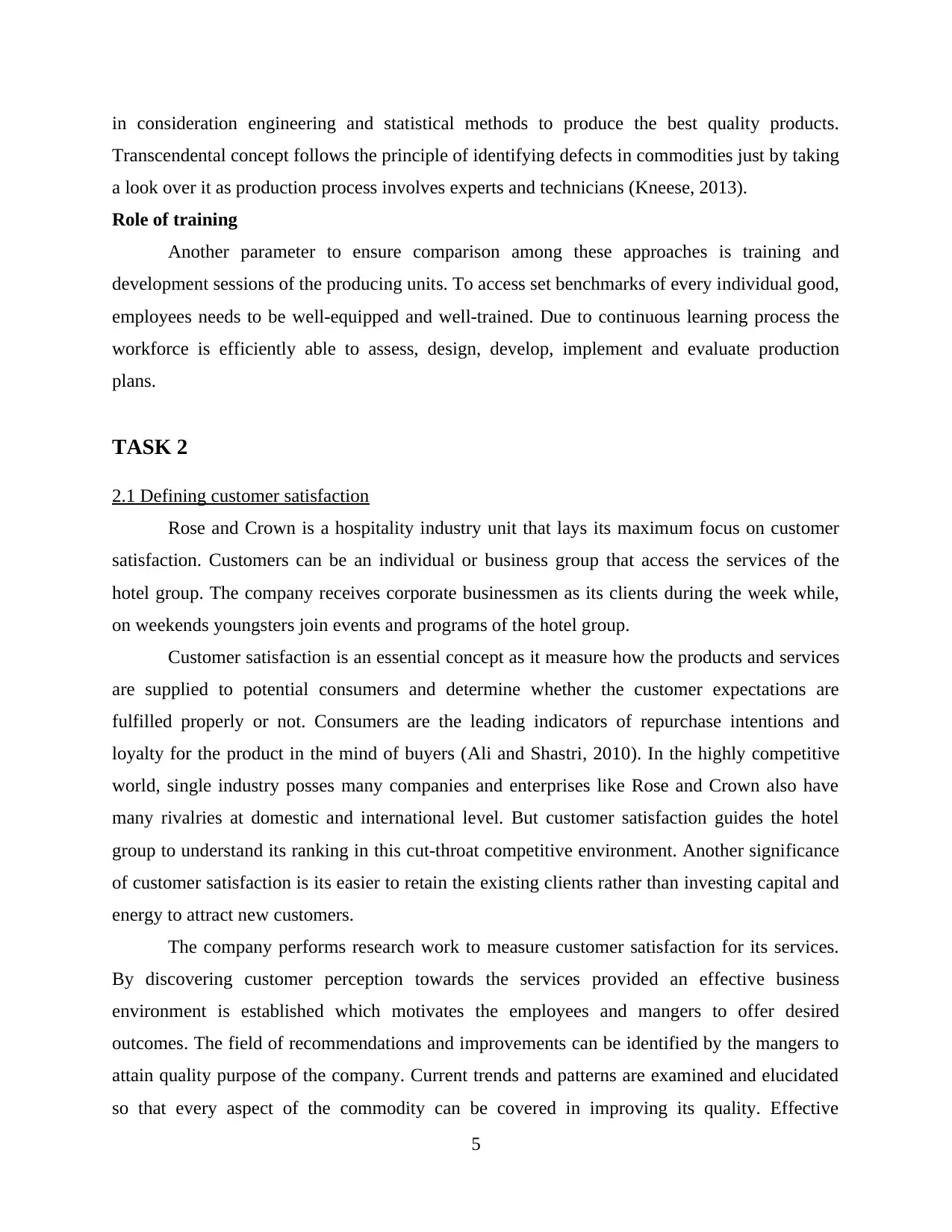
in consideration engineering and statistical methods to produce the best quality products.
Transcendental concept follows the principle of identifying defects in commodities just by taking
a look over it as production process involves experts and technicians (Kneese, 2013).
Role of training
Another parameter to ensure comparison among these approaches is training and
development sessions of the producing units. To access set benchmarks of every individual good,
employees needs to be well-equipped and well-trained. Due to continuous learning process the
workforce is efficiently able to assess, design, develop, implement and evaluate production
plans.
TASK 2
2.1 Defining customer satisfaction
Rose and Crown is a hospitality industry unit that lays its maximum focus on customer
satisfaction. Customers can be an individual or business group that access the services of the
hotel group. The company receives corporate businessmen as its clients during the week while,
on weekends youngsters join events and programs of the hotel group.
Customer satisfaction is an essential concept as it measure how the products and services
are supplied to potential consumers and determine whether the customer expectations are
fulfilled properly or not. Consumers are the leading indicators of repurchase intentions and
loyalty for the product in the mind of buyers (Ali and Shastri, 2010). In the highly competitive
world, single industry posses many companies and enterprises like Rose and Crown also have
many rivalries at domestic and international level. But customer satisfaction guides the hotel
group to understand its ranking in this cut-throat competitive environment. Another significance
of customer satisfaction is its easier to retain the existing clients rather than investing capital and
energy to attract new customers.
The company performs research work to measure customer satisfaction for its services.
By discovering customer perception towards the services provided an effective business
environment is established which motivates the employees and mangers to offer desired
outcomes. The field of recommendations and improvements can be identified by the mangers to
attain quality purpose of the company. Current trends and patterns are examined and elucidated
so that every aspect of the commodity can be covered in improving its quality. Effective
5
Transcendental concept follows the principle of identifying defects in commodities just by taking
a look over it as production process involves experts and technicians (Kneese, 2013).
Role of training
Another parameter to ensure comparison among these approaches is training and
development sessions of the producing units. To access set benchmarks of every individual good,
employees needs to be well-equipped and well-trained. Due to continuous learning process the
workforce is efficiently able to assess, design, develop, implement and evaluate production
plans.
TASK 2
2.1 Defining customer satisfaction
Rose and Crown is a hospitality industry unit that lays its maximum focus on customer
satisfaction. Customers can be an individual or business group that access the services of the
hotel group. The company receives corporate businessmen as its clients during the week while,
on weekends youngsters join events and programs of the hotel group.
Customer satisfaction is an essential concept as it measure how the products and services
are supplied to potential consumers and determine whether the customer expectations are
fulfilled properly or not. Consumers are the leading indicators of repurchase intentions and
loyalty for the product in the mind of buyers (Ali and Shastri, 2010). In the highly competitive
world, single industry posses many companies and enterprises like Rose and Crown also have
many rivalries at domestic and international level. But customer satisfaction guides the hotel
group to understand its ranking in this cut-throat competitive environment. Another significance
of customer satisfaction is its easier to retain the existing clients rather than investing capital and
energy to attract new customers.
The company performs research work to measure customer satisfaction for its services.
By discovering customer perception towards the services provided an effective business
environment is established which motivates the employees and mangers to offer desired
outcomes. The field of recommendations and improvements can be identified by the mangers to
attain quality purpose of the company. Current trends and patterns are examined and elucidated
so that every aspect of the commodity can be covered in improving its quality. Effective
5
Paraphrase This Document
Need a fresh take? Get an instant paraphrase of this document with our AI Paraphraser
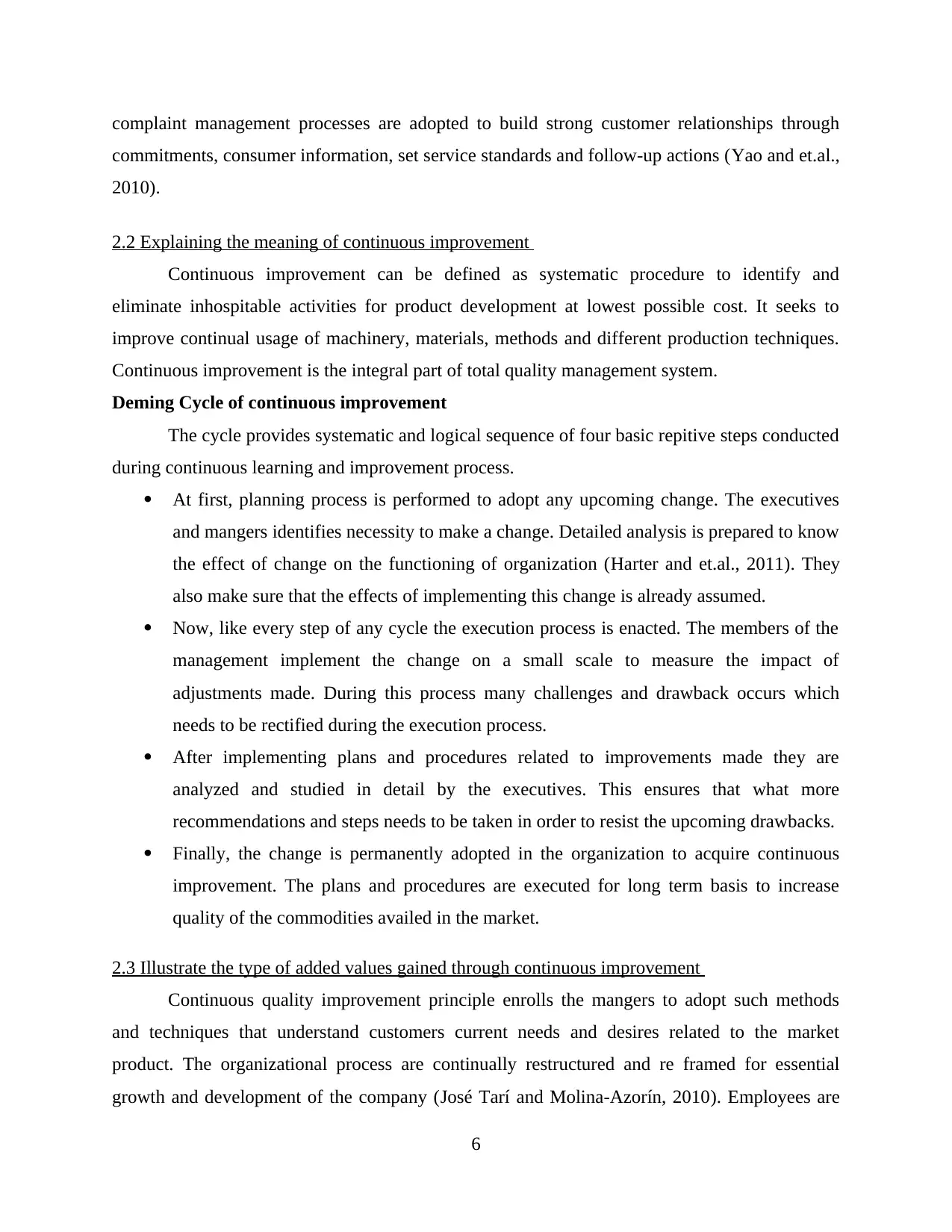
complaint management processes are adopted to build strong customer relationships through
commitments, consumer information, set service standards and follow-up actions (Yao and et.al.,
2010).
2.2 Explaining the meaning of continuous improvement
Continuous improvement can be defined as systematic procedure to identify and
eliminate inhospitable activities for product development at lowest possible cost. It seeks to
improve continual usage of machinery, materials, methods and different production techniques.
Continuous improvement is the integral part of total quality management system.
Deming Cycle of continuous improvement
The cycle provides systematic and logical sequence of four basic repitive steps conducted
during continuous learning and improvement process.
At first, planning process is performed to adopt any upcoming change. The executives
and mangers identifies necessity to make a change. Detailed analysis is prepared to know
the effect of change on the functioning of organization (Harter and et.al., 2011). They
also make sure that the effects of implementing this change is already assumed.
Now, like every step of any cycle the execution process is enacted. The members of the
management implement the change on a small scale to measure the impact of
adjustments made. During this process many challenges and drawback occurs which
needs to be rectified during the execution process.
After implementing plans and procedures related to improvements made they are
analyzed and studied in detail by the executives. This ensures that what more
recommendations and steps needs to be taken in order to resist the upcoming drawbacks.
Finally, the change is permanently adopted in the organization to acquire continuous
improvement. The plans and procedures are executed for long term basis to increase
quality of the commodities availed in the market.
2.3 Illustrate the type of added values gained through continuous improvement
Continuous quality improvement principle enrolls the mangers to adopt such methods
and techniques that understand customers current needs and desires related to the market
product. The organizational process are continually restructured and re framed for essential
growth and development of the company (José Tarí and Molina-Azorín, 2010). Employees are
6
commitments, consumer information, set service standards and follow-up actions (Yao and et.al.,
2010).
2.2 Explaining the meaning of continuous improvement
Continuous improvement can be defined as systematic procedure to identify and
eliminate inhospitable activities for product development at lowest possible cost. It seeks to
improve continual usage of machinery, materials, methods and different production techniques.
Continuous improvement is the integral part of total quality management system.
Deming Cycle of continuous improvement
The cycle provides systematic and logical sequence of four basic repitive steps conducted
during continuous learning and improvement process.
At first, planning process is performed to adopt any upcoming change. The executives
and mangers identifies necessity to make a change. Detailed analysis is prepared to know
the effect of change on the functioning of organization (Harter and et.al., 2011). They
also make sure that the effects of implementing this change is already assumed.
Now, like every step of any cycle the execution process is enacted. The members of the
management implement the change on a small scale to measure the impact of
adjustments made. During this process many challenges and drawback occurs which
needs to be rectified during the execution process.
After implementing plans and procedures related to improvements made they are
analyzed and studied in detail by the executives. This ensures that what more
recommendations and steps needs to be taken in order to resist the upcoming drawbacks.
Finally, the change is permanently adopted in the organization to acquire continuous
improvement. The plans and procedures are executed for long term basis to increase
quality of the commodities availed in the market.
2.3 Illustrate the type of added values gained through continuous improvement
Continuous quality improvement principle enrolls the mangers to adopt such methods
and techniques that understand customers current needs and desires related to the market
product. The organizational process are continually restructured and re framed for essential
growth and development of the company (José Tarí and Molina-Azorín, 2010). Employees are
6
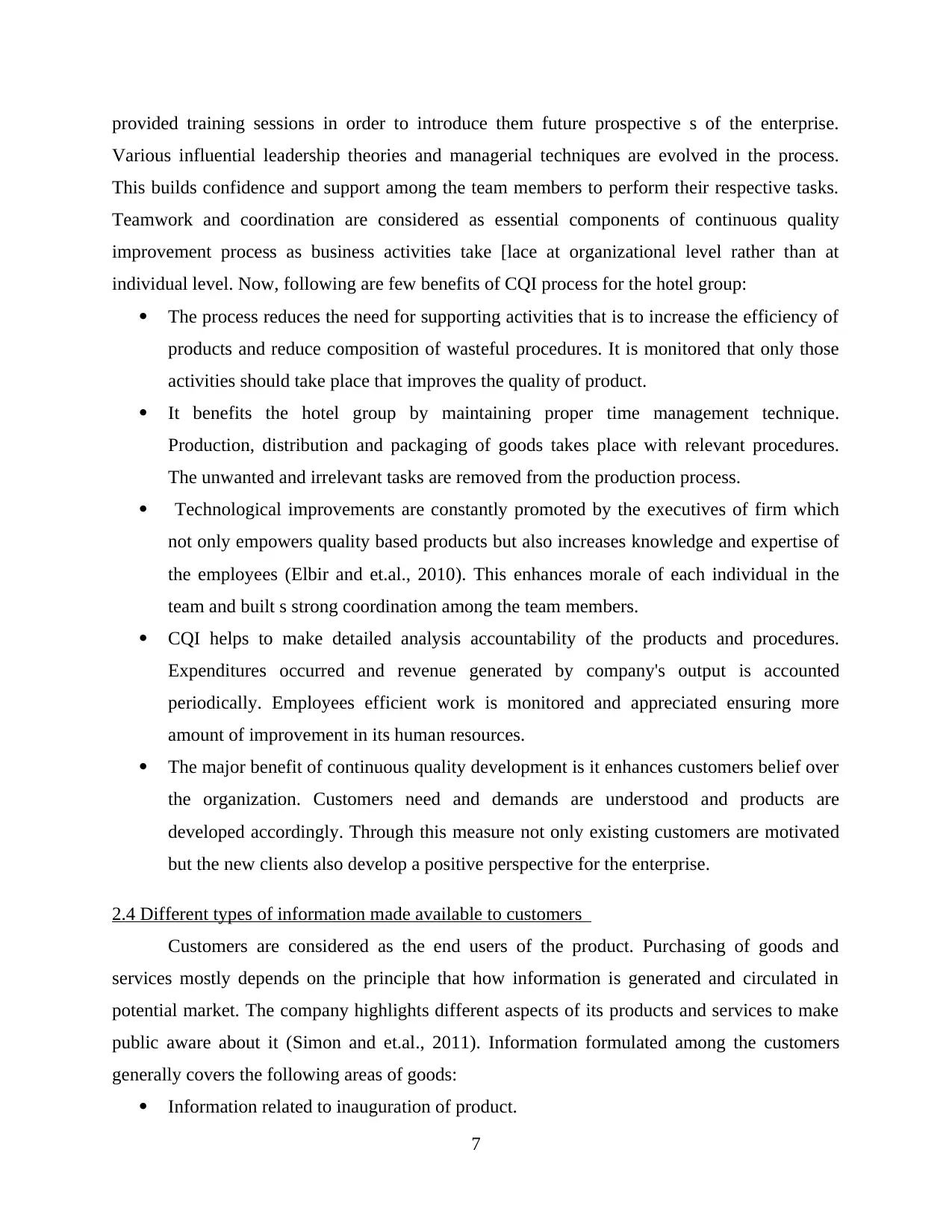
provided training sessions in order to introduce them future prospective s of the enterprise.
Various influential leadership theories and managerial techniques are evolved in the process.
This builds confidence and support among the team members to perform their respective tasks.
Teamwork and coordination are considered as essential components of continuous quality
improvement process as business activities take [lace at organizational level rather than at
individual level. Now, following are few benefits of CQI process for the hotel group:
The process reduces the need for supporting activities that is to increase the efficiency of
products and reduce composition of wasteful procedures. It is monitored that only those
activities should take place that improves the quality of product.
It benefits the hotel group by maintaining proper time management technique.
Production, distribution and packaging of goods takes place with relevant procedures.
The unwanted and irrelevant tasks are removed from the production process.
Technological improvements are constantly promoted by the executives of firm which
not only empowers quality based products but also increases knowledge and expertise of
the employees (Elbir and et.al., 2010). This enhances morale of each individual in the
team and built s strong coordination among the team members.
CQI helps to make detailed analysis accountability of the products and procedures.
Expenditures occurred and revenue generated by company's output is accounted
periodically. Employees efficient work is monitored and appreciated ensuring more
amount of improvement in its human resources.
The major benefit of continuous quality development is it enhances customers belief over
the organization. Customers need and demands are understood and products are
developed accordingly. Through this measure not only existing customers are motivated
but the new clients also develop a positive perspective for the enterprise.
2.4 Different types of information made available to customers
Customers are considered as the end users of the product. Purchasing of goods and
services mostly depends on the principle that how information is generated and circulated in
potential market. The company highlights different aspects of its products and services to make
public aware about it (Simon and et.al., 2011). Information formulated among the customers
generally covers the following areas of goods:
Information related to inauguration of product.
7
Various influential leadership theories and managerial techniques are evolved in the process.
This builds confidence and support among the team members to perform their respective tasks.
Teamwork and coordination are considered as essential components of continuous quality
improvement process as business activities take [lace at organizational level rather than at
individual level. Now, following are few benefits of CQI process for the hotel group:
The process reduces the need for supporting activities that is to increase the efficiency of
products and reduce composition of wasteful procedures. It is monitored that only those
activities should take place that improves the quality of product.
It benefits the hotel group by maintaining proper time management technique.
Production, distribution and packaging of goods takes place with relevant procedures.
The unwanted and irrelevant tasks are removed from the production process.
Technological improvements are constantly promoted by the executives of firm which
not only empowers quality based products but also increases knowledge and expertise of
the employees (Elbir and et.al., 2010). This enhances morale of each individual in the
team and built s strong coordination among the team members.
CQI helps to make detailed analysis accountability of the products and procedures.
Expenditures occurred and revenue generated by company's output is accounted
periodically. Employees efficient work is monitored and appreciated ensuring more
amount of improvement in its human resources.
The major benefit of continuous quality development is it enhances customers belief over
the organization. Customers need and demands are understood and products are
developed accordingly. Through this measure not only existing customers are motivated
but the new clients also develop a positive perspective for the enterprise.
2.4 Different types of information made available to customers
Customers are considered as the end users of the product. Purchasing of goods and
services mostly depends on the principle that how information is generated and circulated in
potential market. The company highlights different aspects of its products and services to make
public aware about it (Simon and et.al., 2011). Information formulated among the customers
generally covers the following areas of goods:
Information related to inauguration of product.
7
⊘ This is a preview!⊘
Do you want full access?
Subscribe today to unlock all pages.

Trusted by 1+ million students worldwide
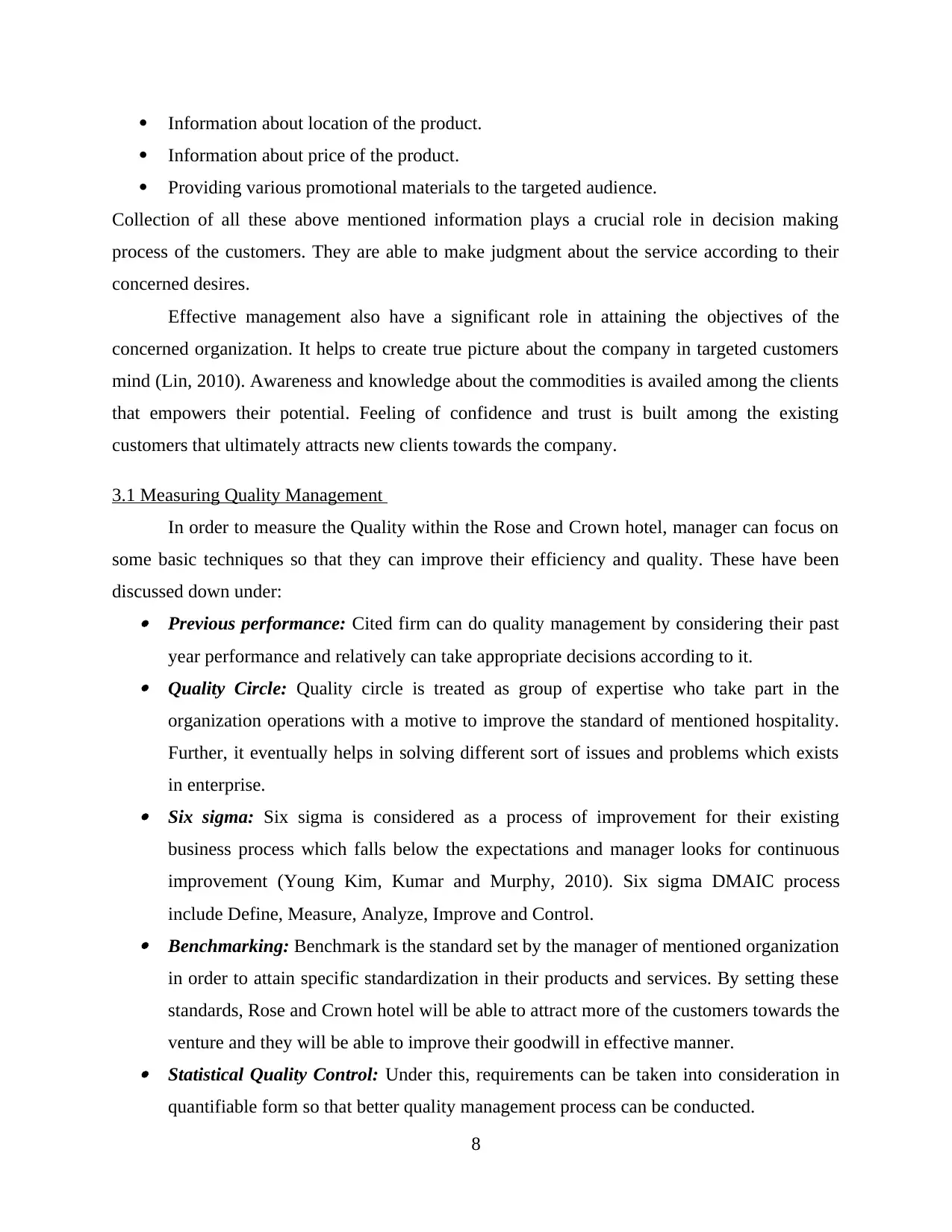
Information about location of the product.
Information about price of the product.
Providing various promotional materials to the targeted audience.
Collection of all these above mentioned information plays a crucial role in decision making
process of the customers. They are able to make judgment about the service according to their
concerned desires.
Effective management also have a significant role in attaining the objectives of the
concerned organization. It helps to create true picture about the company in targeted customers
mind (Lin, 2010). Awareness and knowledge about the commodities is availed among the clients
that empowers their potential. Feeling of confidence and trust is built among the existing
customers that ultimately attracts new clients towards the company.
3.1 Measuring Quality Management
In order to measure the Quality within the Rose and Crown hotel, manager can focus on
some basic techniques so that they can improve their efficiency and quality. These have been
discussed down under: Previous performance: Cited firm can do quality management by considering their past
year performance and relatively can take appropriate decisions according to it. Quality Circle: Quality circle is treated as group of expertise who take part in the
organization operations with a motive to improve the standard of mentioned hospitality.
Further, it eventually helps in solving different sort of issues and problems which exists
in enterprise. Six sigma: Six sigma is considered as a process of improvement for their existing
business process which falls below the expectations and manager looks for continuous
improvement (Young Kim, Kumar and Murphy, 2010). Six sigma DMAIC process
include Define, Measure, Analyze, Improve and Control. Benchmarking: Benchmark is the standard set by the manager of mentioned organization
in order to attain specific standardization in their products and services. By setting these
standards, Rose and Crown hotel will be able to attract more of the customers towards the
venture and they will be able to improve their goodwill in effective manner. Statistical Quality Control: Under this, requirements can be taken into consideration in
quantifiable form so that better quality management process can be conducted.
8
Information about price of the product.
Providing various promotional materials to the targeted audience.
Collection of all these above mentioned information plays a crucial role in decision making
process of the customers. They are able to make judgment about the service according to their
concerned desires.
Effective management also have a significant role in attaining the objectives of the
concerned organization. It helps to create true picture about the company in targeted customers
mind (Lin, 2010). Awareness and knowledge about the commodities is availed among the clients
that empowers their potential. Feeling of confidence and trust is built among the existing
customers that ultimately attracts new clients towards the company.
3.1 Measuring Quality Management
In order to measure the Quality within the Rose and Crown hotel, manager can focus on
some basic techniques so that they can improve their efficiency and quality. These have been
discussed down under: Previous performance: Cited firm can do quality management by considering their past
year performance and relatively can take appropriate decisions according to it. Quality Circle: Quality circle is treated as group of expertise who take part in the
organization operations with a motive to improve the standard of mentioned hospitality.
Further, it eventually helps in solving different sort of issues and problems which exists
in enterprise. Six sigma: Six sigma is considered as a process of improvement for their existing
business process which falls below the expectations and manager looks for continuous
improvement (Young Kim, Kumar and Murphy, 2010). Six sigma DMAIC process
include Define, Measure, Analyze, Improve and Control. Benchmarking: Benchmark is the standard set by the manager of mentioned organization
in order to attain specific standardization in their products and services. By setting these
standards, Rose and Crown hotel will be able to attract more of the customers towards the
venture and they will be able to improve their goodwill in effective manner. Statistical Quality Control: Under this, requirements can be taken into consideration in
quantifiable form so that better quality management process can be conducted.
8
Paraphrase This Document
Need a fresh take? Get an instant paraphrase of this document with our AI Paraphraser
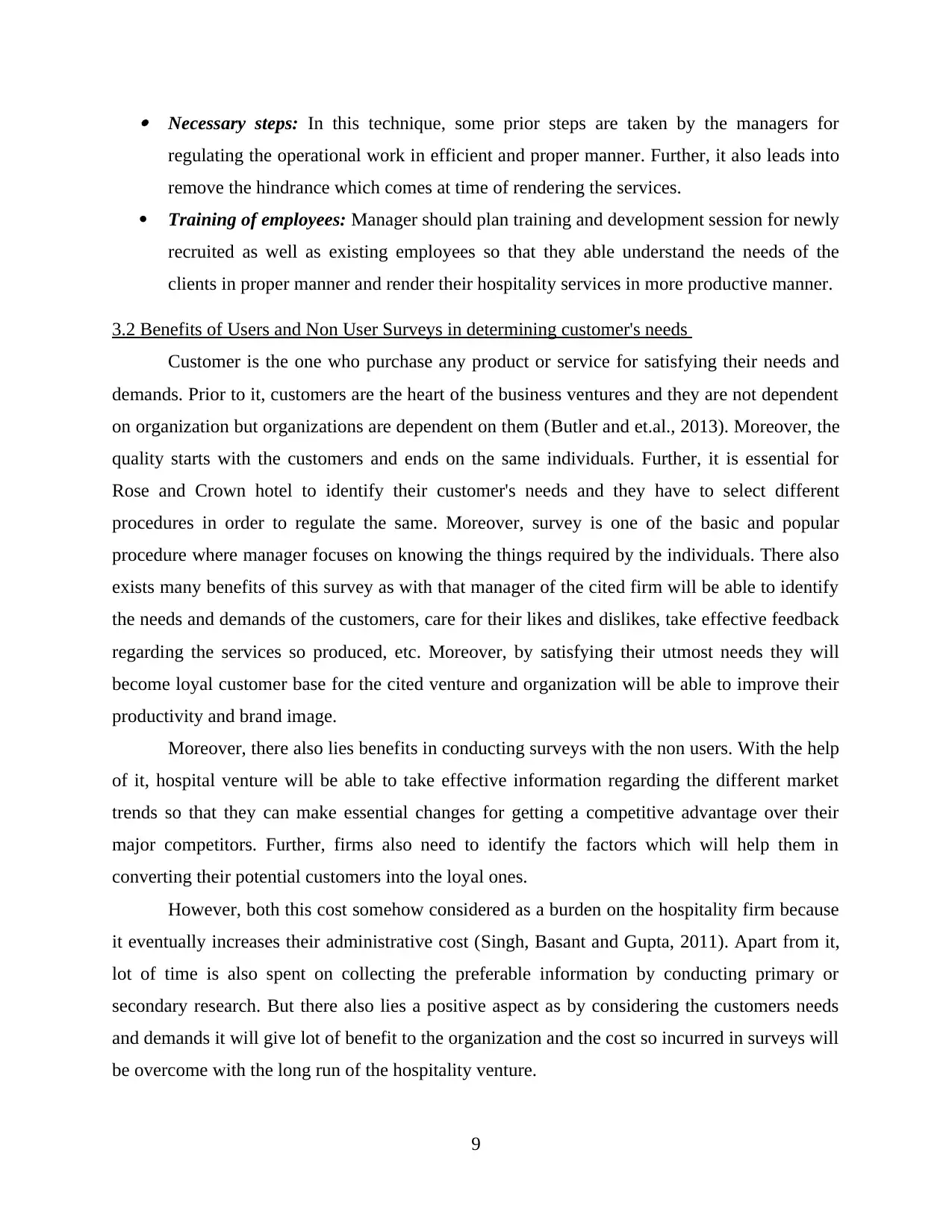
Necessary steps: In this technique, some prior steps are taken by the managers for
regulating the operational work in efficient and proper manner. Further, it also leads into
remove the hindrance which comes at time of rendering the services.
Training of employees: Manager should plan training and development session for newly
recruited as well as existing employees so that they able understand the needs of the
clients in proper manner and render their hospitality services in more productive manner.
3.2 Benefits of Users and Non User Surveys in determining customer's needs
Customer is the one who purchase any product or service for satisfying their needs and
demands. Prior to it, customers are the heart of the business ventures and they are not dependent
on organization but organizations are dependent on them (Butler and et.al., 2013). Moreover, the
quality starts with the customers and ends on the same individuals. Further, it is essential for
Rose and Crown hotel to identify their customer's needs and they have to select different
procedures in order to regulate the same. Moreover, survey is one of the basic and popular
procedure where manager focuses on knowing the things required by the individuals. There also
exists many benefits of this survey as with that manager of the cited firm will be able to identify
the needs and demands of the customers, care for their likes and dislikes, take effective feedback
regarding the services so produced, etc. Moreover, by satisfying their utmost needs they will
become loyal customer base for the cited venture and organization will be able to improve their
productivity and brand image.
Moreover, there also lies benefits in conducting surveys with the non users. With the help
of it, hospital venture will be able to take effective information regarding the different market
trends so that they can make essential changes for getting a competitive advantage over their
major competitors. Further, firms also need to identify the factors which will help them in
converting their potential customers into the loyal ones.
However, both this cost somehow considered as a burden on the hospitality firm because
it eventually increases their administrative cost (Singh, Basant and Gupta, 2011). Apart from it,
lot of time is also spent on collecting the preferable information by conducting primary or
secondary research. But there also lies a positive aspect as by considering the customers needs
and demands it will give lot of benefit to the organization and the cost so incurred in surveys will
be overcome with the long run of the hospitality venture.
9
regulating the operational work in efficient and proper manner. Further, it also leads into
remove the hindrance which comes at time of rendering the services.
Training of employees: Manager should plan training and development session for newly
recruited as well as existing employees so that they able understand the needs of the
clients in proper manner and render their hospitality services in more productive manner.
3.2 Benefits of Users and Non User Surveys in determining customer's needs
Customer is the one who purchase any product or service for satisfying their needs and
demands. Prior to it, customers are the heart of the business ventures and they are not dependent
on organization but organizations are dependent on them (Butler and et.al., 2013). Moreover, the
quality starts with the customers and ends on the same individuals. Further, it is essential for
Rose and Crown hotel to identify their customer's needs and they have to select different
procedures in order to regulate the same. Moreover, survey is one of the basic and popular
procedure where manager focuses on knowing the things required by the individuals. There also
exists many benefits of this survey as with that manager of the cited firm will be able to identify
the needs and demands of the customers, care for their likes and dislikes, take effective feedback
regarding the services so produced, etc. Moreover, by satisfying their utmost needs they will
become loyal customer base for the cited venture and organization will be able to improve their
productivity and brand image.
Moreover, there also lies benefits in conducting surveys with the non users. With the help
of it, hospital venture will be able to take effective information regarding the different market
trends so that they can make essential changes for getting a competitive advantage over their
major competitors. Further, firms also need to identify the factors which will help them in
converting their potential customers into the loyal ones.
However, both this cost somehow considered as a burden on the hospitality firm because
it eventually increases their administrative cost (Singh, Basant and Gupta, 2011). Apart from it,
lot of time is also spent on collecting the preferable information by conducting primary or
secondary research. But there also lies a positive aspect as by considering the customers needs
and demands it will give lot of benefit to the organization and the cost so incurred in surveys will
be overcome with the long run of the hospitality venture.
9
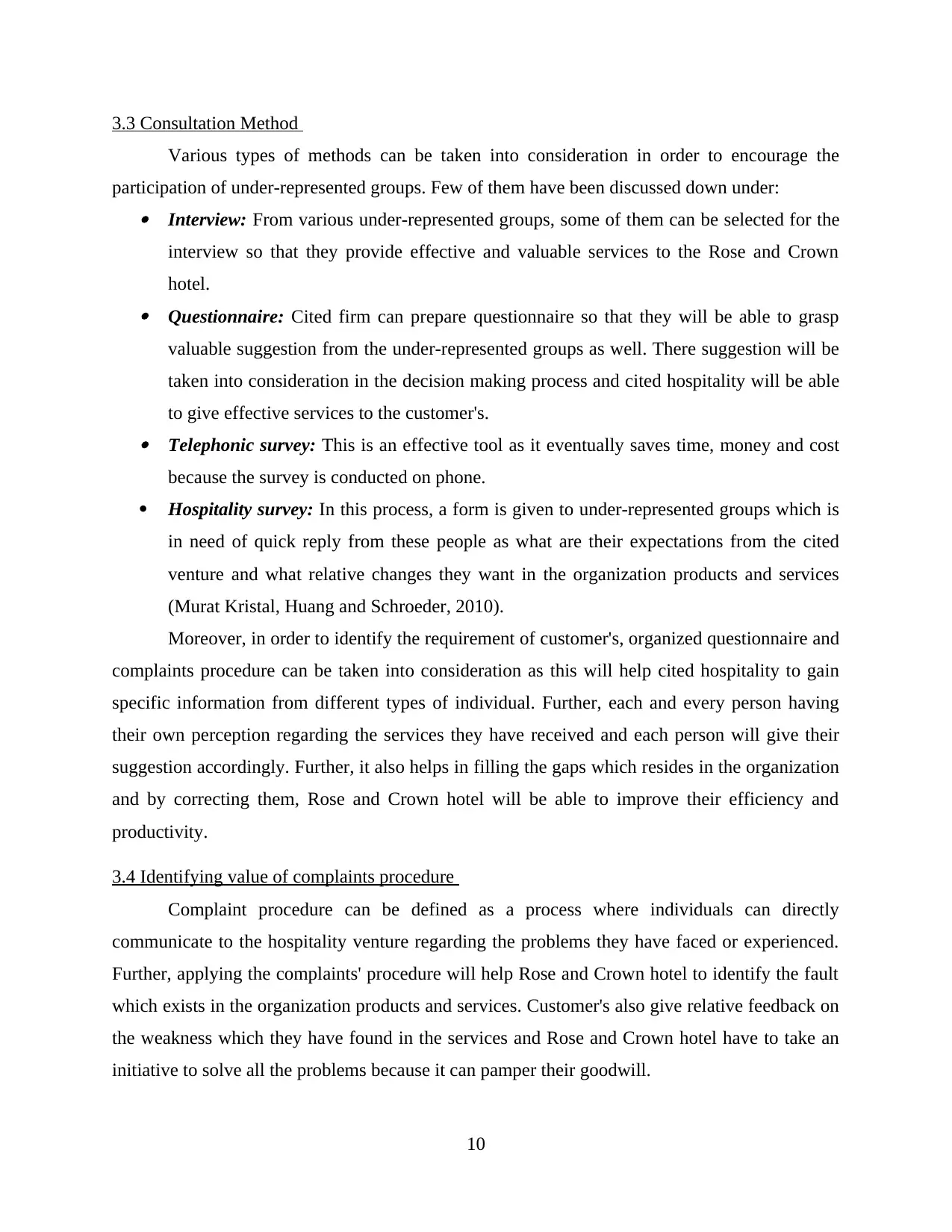
3.3 Consultation Method
Various types of methods can be taken into consideration in order to encourage the
participation of under-represented groups. Few of them have been discussed down under: Interview: From various under-represented groups, some of them can be selected for the
interview so that they provide effective and valuable services to the Rose and Crown
hotel. Questionnaire: Cited firm can prepare questionnaire so that they will be able to grasp
valuable suggestion from the under-represented groups as well. There suggestion will be
taken into consideration in the decision making process and cited hospitality will be able
to give effective services to the customer's. Telephonic survey: This is an effective tool as it eventually saves time, money and cost
because the survey is conducted on phone.
Hospitality survey: In this process, a form is given to under-represented groups which is
in need of quick reply from these people as what are their expectations from the cited
venture and what relative changes they want in the organization products and services
(Murat Kristal, Huang and Schroeder, 2010).
Moreover, in order to identify the requirement of customer's, organized questionnaire and
complaints procedure can be taken into consideration as this will help cited hospitality to gain
specific information from different types of individual. Further, each and every person having
their own perception regarding the services they have received and each person will give their
suggestion accordingly. Further, it also helps in filling the gaps which resides in the organization
and by correcting them, Rose and Crown hotel will be able to improve their efficiency and
productivity.
3.4 Identifying value of complaints procedure
Complaint procedure can be defined as a process where individuals can directly
communicate to the hospitality venture regarding the problems they have faced or experienced.
Further, applying the complaints' procedure will help Rose and Crown hotel to identify the fault
which exists in the organization products and services. Customer's also give relative feedback on
the weakness which they have found in the services and Rose and Crown hotel have to take an
initiative to solve all the problems because it can pamper their goodwill.
10
Various types of methods can be taken into consideration in order to encourage the
participation of under-represented groups. Few of them have been discussed down under: Interview: From various under-represented groups, some of them can be selected for the
interview so that they provide effective and valuable services to the Rose and Crown
hotel. Questionnaire: Cited firm can prepare questionnaire so that they will be able to grasp
valuable suggestion from the under-represented groups as well. There suggestion will be
taken into consideration in the decision making process and cited hospitality will be able
to give effective services to the customer's. Telephonic survey: This is an effective tool as it eventually saves time, money and cost
because the survey is conducted on phone.
Hospitality survey: In this process, a form is given to under-represented groups which is
in need of quick reply from these people as what are their expectations from the cited
venture and what relative changes they want in the organization products and services
(Murat Kristal, Huang and Schroeder, 2010).
Moreover, in order to identify the requirement of customer's, organized questionnaire and
complaints procedure can be taken into consideration as this will help cited hospitality to gain
specific information from different types of individual. Further, each and every person having
their own perception regarding the services they have received and each person will give their
suggestion accordingly. Further, it also helps in filling the gaps which resides in the organization
and by correcting them, Rose and Crown hotel will be able to improve their efficiency and
productivity.
3.4 Identifying value of complaints procedure
Complaint procedure can be defined as a process where individuals can directly
communicate to the hospitality venture regarding the problems they have faced or experienced.
Further, applying the complaints' procedure will help Rose and Crown hotel to identify the fault
which exists in the organization products and services. Customer's also give relative feedback on
the weakness which they have found in the services and Rose and Crown hotel have to take an
initiative to solve all the problems because it can pamper their goodwill.
10
⊘ This is a preview!⊘
Do you want full access?
Subscribe today to unlock all pages.

Trusted by 1+ million students worldwide
1 out of 19
Related Documents
Your All-in-One AI-Powered Toolkit for Academic Success.
+13062052269
info@desklib.com
Available 24*7 on WhatsApp / Email
![[object Object]](/_next/static/media/star-bottom.7253800d.svg)
Unlock your academic potential
Copyright © 2020–2025 A2Z Services. All Rights Reserved. Developed and managed by ZUCOL.





